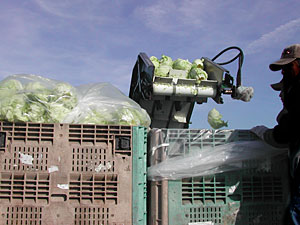
Harvesting into bulk boxes for fresh cut bagged lettuce.
Food safety is everyone's responsibility. Growers are doing their part by developing individual farm food safety plans and refining them each year. In 1999 New Jersey farmers started to implement food safety practices prompted by a request from supermarkets. The New Jersey Department of Agriculture (NJDA), in collaboration with Rutgers New Jersey Agricultural Experiment Station (NJAES), took the lead in developing the first statewide third-party audit system in the country to help growers evaluate their operations for food safety. This system was incorporated into the United States Department of Agriculture's (USDA) Good Agricultural Practices and Good Handling Practices Audit Verification Program.
Growers develop their own food safety plans to address hazards on their farms that may lead to product contamination. Water sources are tested to determine if they could be a source of pathogens, just as homeowners have water tested when their house is to be sold. Growers follow a stricter schedule by testing water two or three times during the growing season. All workers on the farm are trained each year on health and hygiene issues. This training informs farm workers of their responsibilities as food handlers and stresses how their personal activities can affect the safety of the food supply.
Each grower evaluates his or her farm to determine if animals or manure management practices could be a source of possible microbial contamination and then makes changes if needed. Growers disinfect and clean harvesting containers, set up a system to inspect for foreign objects in the product, and ensure that the proper quality water is used for irrigation and packing.
Farmers evaluate their packinghouses to determine if there are opportunities for contamination during receiving, on the washing/packing line, and during storage and transportation. Packinghouses are also cleaned before the season starts to remove any dirt or contamination that may have built up over the winter. Packing lines are cleaned at the end of each day to reduce the potential for microbial contamination. If ice is used in packing, growers obtain reports from the ice plant as to water quality and the supplier's schedule for cleaning equipment.
It is important to ensure all harvested product is maintained at the proper temperature. Growers check their cold rooms each day to make sure fruits and vegetables are kept at recommended temperatures. Temperature control is one of the most important ways to ensure good quality produce in the market and improve food safety.
Growers have started to implement a traceback system for produce items. Some growers in New Jersey can now follow their produce from the field, to the packinghouse, to the wholesale buyer, and on to the supermarket. Traceback systems will become more important as the Food and Drug Administration now uses them to determine the source of foodborne illness outbreaks.
Once growers do a self evaluation and modify their food safety plans as needed, Rutgers NJAES works with them at their request to review their food safety plans and facilities prior to the third-party audit. Many growers in New Jersey have the NJDA's auditors perform the audit. Once the audit is successfully completed, the grower receives a certificate. In addition, the grower's information is placed on the USDA website so that buyers can easily determine which farm operations have been audited.
With the exception of Florida's new food safety practices required for tomato growers, grower participation in food safety audits is voluntary. New Jersey is a leading state, especially in the Northeast and Mid-Atlantic, in grower training and participation in food safety audits. Rutgers NJAES, in collaboration with the NJDA, has trained more than 3,300 individuals since 1999 on food safety, third-party audits, and train-the-trainer sessions, in addition to developing manuals and writing newsletter columns.

